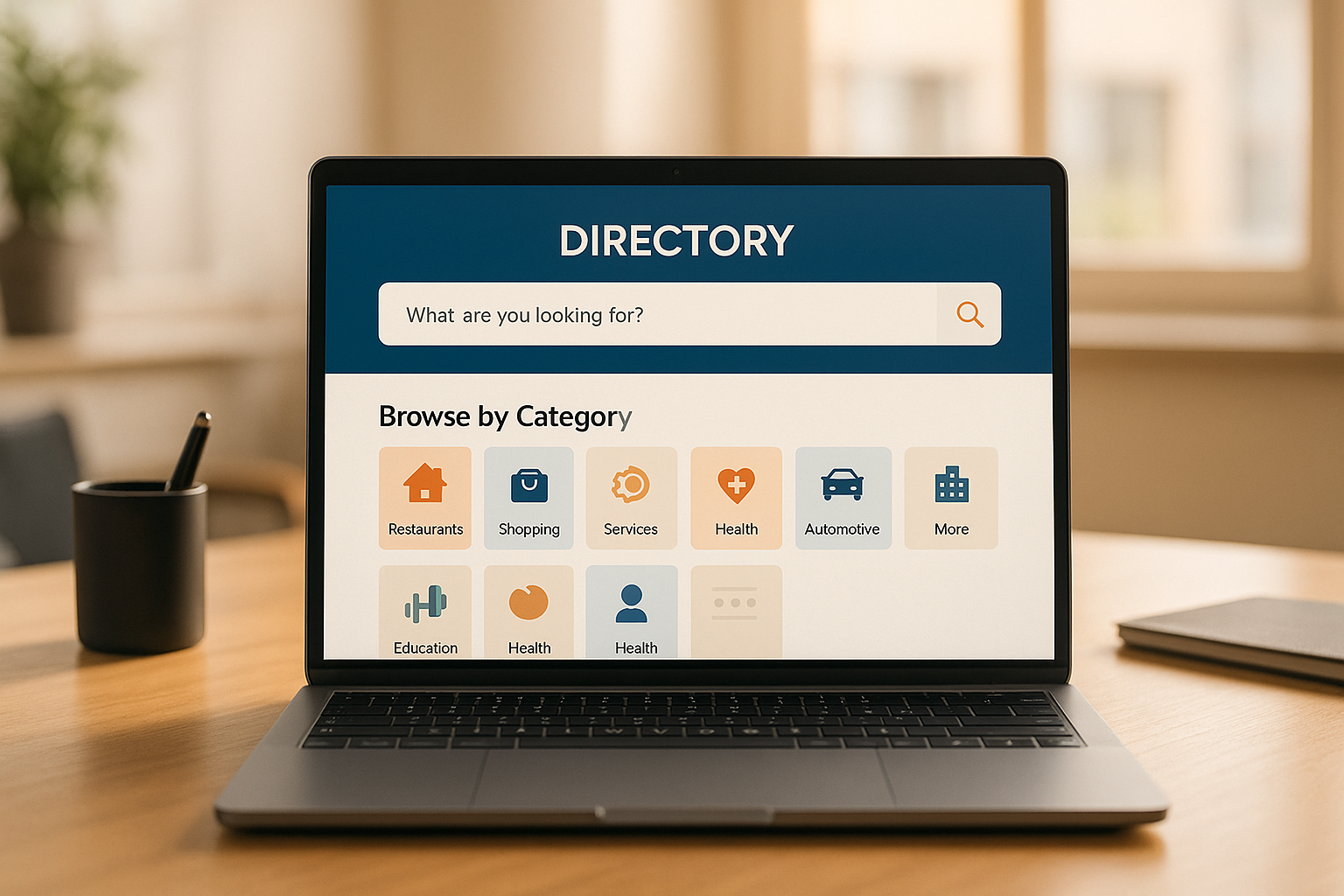

The success of your directory website largely depends on the platform you initially choose, much like selecting the right spot for constructing a house impacts daily functions and potential growth. This critical decision requires looking past just the initial setup costs and basic functionalities.
Experienced directory site owners often highlight scalability as paramount. Your platform should accommodate substantial growth in listings and traffic without compromising performance. Similar to planting a tree, you need a robust foundation to support future expansion.
Technical capabilities are also crucial. Important features to evaluate include advanced search functions, customizable filters, and user-submitted listings acceptance. A strong selection of add-ons and extensions can significantly influence how well you adapt your site over time.
Directify emerges as a strong contender, offering a no-code directory builder solution to directory website creation. With its focus on simplicity and efficiency, Directify provides a versatile platform for building and managing directory websites. For more statistics, explore Directify usage data.
Directify delivers great flexibility through its comprehensive ecosystem. Tools like GeoDirectory and Business Directory Plugin provide essential features for managing listings and user interactions. Success, however, requires understanding how these tools integrate and support your SEO strategy.
Real-world examples demonstrate effective strategies and potential pitfalls. Some directories thrive by targeting specific niches and creating specialized features, while others falter due to scaling difficulties or neglecting user experience. Discover more about different approaches in our guide to Directory Website vs. Business Directory: Key Differences.
Your platform choice should consider budget, technical skills, and growth objectives. Take the time to thoroughly evaluate options, as this decision affects your directory's long-term success. Seek a platform that not only fulfills current needs but also supports future goals and helps you compete effectively in your market.
Creating a successful directory involves more than just listing businesses; it’s about connecting your audience with the resources they need. Effective research identifies market gaps and reveals what your target users are searching for but struggling to find.
Successful directory owners often succeed by focusing on underserved markets with specific needs. For instance, a directory highlighting sustainable businesses in a particular region can link eco-conscious consumers with local green companies. This focus improves marketing effectiveness and helps build an engaged community around a shared interest.
Gathering direct feedback via user surveys and interviews is vital before launch. These discussions help structure categories effectively and reveal the most valued features. View it as a test flight—you need to confirm everything works before taking off.
Examining successful directories in your field provides valuable insights. Study what works well and pinpoint where you can offer something better or different. Understanding the competitive landscape helps position your directory for long-term success.
Local business directories show strong potential, with searches for nearby businesses increasing by over 500% recently. This indicates high user demand that a well-designed directory can meet. Learn more about directory growth trends here.
Your directory requires a clear unique value proposition (UVP) that distinguishes it. This could be exclusive listings, higher quality standards, or deep expertise in a specific area or industry. A compelling UVP gives users a clear reason to choose your directory over alternatives.
Clear, intuitive category organization is essential for user experience. Like an organized library, your directory should allow visitors to find what they need easily. Pay attention to how users search and navigate, and add smart filtering options that align with their behavior. When users can quickly and easily find information, they're more likely to return and recommend your directory.
API access.outrank.so/storage/v1/object/public/article-images/bf6bc45e-f460-44a2-8d2e-77771f0bfed8/ai-image-59f9210b-e362-4815-af8f-a8434f6e8d5f.jpg" alt="AI and Directory Websites" />
AI tools enable more efficient directory management while enhancing user experiences. The key is balancing automated processes with human oversight to maintain quality.
AI excels at handling repetitive directory management tasks. For example, AI tools can automatically categorize new business listings based on descriptions, saving hours of manual work. They can also generate initial listing descriptions for editors to refine. This allows more time to focus on user experience and strategic planning.
AI capabilities can greatly enhance user interactions with your directory. Intelligent search is one notable example—AI algorithms can understand user queries and display relevant results even when search terms don't exactly match listing content. This ensures users find what they need even if they're unsure of the exact keywords.
Automated verification is another useful AI application. The technology can scan listings to identify potential inaccuracies or fraudulent information, maintaining directory quality without manually checking each entry. One directory creator used AI tools to build a complete site in just 24 hours while maintaining high standards. You can read more about their approach here.
Adding AI features doesn't require advanced technical skills. Platforms like Directify offer AI-enabled capabilities such as smart search and automated content generation. This makes it simple to enhance your directory with AI while maintaining control over the final outcome.
The thoughtful use of AI tools can help build and manage a more efficient directory while improving user experiences. While automation handles routine tasks, you can focus on strategy and quality control. Remember that human oversight remains crucial—AI complements human judgment rather than replacing it.
Monetizing your directory website is vital for long-term success. Like any business, your online directory needs reliable revenue sources to grow and thrive. This requires careful planning around pricing, payment systems, and building lasting client relationships.
Several proven methods can turn your directory into a profitable business. Premium listings offer businesses enhanced visibility and special features for a higher fee—similar to prime retail space on a busy street. Want to learn more? Check out: How to add paid listings to your directory website.
Targeted advertising can be highly effective when executed well. Understanding your audience allows you to offer ad placements that yield strong results. Finding the right balance is key—too many ads can hurt the user experience while too few may not generate sufficient revenue.
Affiliate marketing offers another income stream. By partnering with relevant businesses in your directory's niche, you can earn commissions from sales generated through your platform. This creates value for users while bringing in additional revenue.
Clear, simple pricing tiers are crucial for success. Offer different premium listing levels with increasing benefits to suit various business budgets. Ensure your payment system is secure and easy to use—a smooth process builds trust and encourages businesses to invest in your platform.
Retaining existing clients is as important as acquiring new ones. Strong relationships with listed businesses create community and foster loyalty. Provide excellent support, address issues promptly, and actively seek feedback to improve continuously. This builds trust and encourages repeat business.
The directory website market shows strong potential. The global website builder industry, including directory sites, is expected to reach $2.1 billion in 2024—an 11% increase from 2022. Learn more here. These numbers underscore the importance of a solid monetization plan.
While revenue is essential, maintaining a great user experience should be your priority. Too many ads or aggressive sales tactics can damage your reputation and drive users away. Consider your directory visitors as guests at a party—you want them to enjoy themselves and return. Creating a positive experience encourages users to return and recommend your platform.
When building a directory website, user experience significantly influences how often people return and whether your business grows. By studying effective directory sites, we can learn key principles for creating an engaging platform that users appreciate.
The search function is central to any directory website. It's like having an expert librarian who can instantly find the right book among thousands. Features such as autocomplete suggestions and faceted search allow users to quickly narrow down their search.
For example, someone searching for "Italian restaurants in Chicago" should be able to filter results by price, outdoor seating, or dietary options. Effective filtering prevents users from being overwhelmed, making them more likely to return to your directory as a trusted resource.
With most people accessing websites on phones and tablets, responsive design is essential. Your directory needs to function smoothly across all devices. Clear text, easy-to-tap buttons, and adaptable layouts keep users engaged no matter how they browse.
Much like a well-organized store, directories need logical structure. Break down broad categories into specific subcategories that make sense to users. For example, under "Restaurants," include sections for cuisines like Italian, Mexican, and Chinese.
Each listing serves as a mini storefront. High-quality images, clear descriptions, and prominent contact details help attract potential customers. Better-looking, better-functioning listings provide more value to both businesses and users.
Good navigation prevents users from feeling lost. A clear menu, visible search bar, and strategic calls-to-action guide visitors naturally through your site. Smart internal linking, like suggesting related categories or similar listings, encourages further exploration and increases engagement.
Building an effective directory requires constant testing and improvement. Listen to user feedback and analyze your metrics to identify areas needing enhancement. For more guidance, check out 7 steps to launching your first online directory website. Continuous refinement ensures your directory meets user needs and builds a thriving community.

Creating a directory website is just the start. The real challenge lies in developing an effective marketing plan to attract visitors and businesses. Success requires careful planning and focused execution rather than random promotional efforts.
Directory websites need to appeal to two key groups: businesses that list their services and users who search the listings. For businesses, clearly communicate how your platform helps them reach new customers and connect with their target market.
Users want an easy way to find what they're looking for. Focus your messaging on your directory's extensive listings, user-friendly search features, and any special capabilities that set it apart. A clean, intuitive website design helps attract and retain both audiences.
Search engine optimization is crucial for driving directory traffic. Start by optimizing your site for relevant keywords, focusing on location-based terms if you run a local directory. This includes optimizing page titles, descriptions, and content, along with building quality backlinks.
Create dedicated category pages targeting specific search terms. For example, a restaurant directory could have separate pages for "Italian Restaurants," "Seafood Restaurants," and other cuisines. This approach helps improve rankings for those specific searches.
Strategic partnerships can quickly expand your directory's reach. Collaborate with complementary businesses and local organizations on joint marketing campaigns, cross-promotion opportunities, and special member offers.
For local directories, community involvement is key. Participate in local events, support community initiatives, and partner with area media outlets. These activities help establish your directory as a trusted local resource.
Quality content naturally attracts both businesses and users. Share useful tips for businesses, create guides for users, and publish articles on local happenings and attractions. Good content drives traffic while positioning your directory as an authority in its field.
Monitor key metrics like website visits, user engagement, and listing growth to understand what's working. Use analytics tools to track progress and identify areas needing improvement.
Growing a successful directory requires ongoing effort—planning, executing, measuring results, and refining your approach. By implementing these marketing strategies and adapting to user needs, you can build a valuable community resource that grows steadily over time. Ready to launch your directory? Start your free trial with Directify today!
Start creating your professional directory website today with Directify's no-code platform.
Get Started Free







